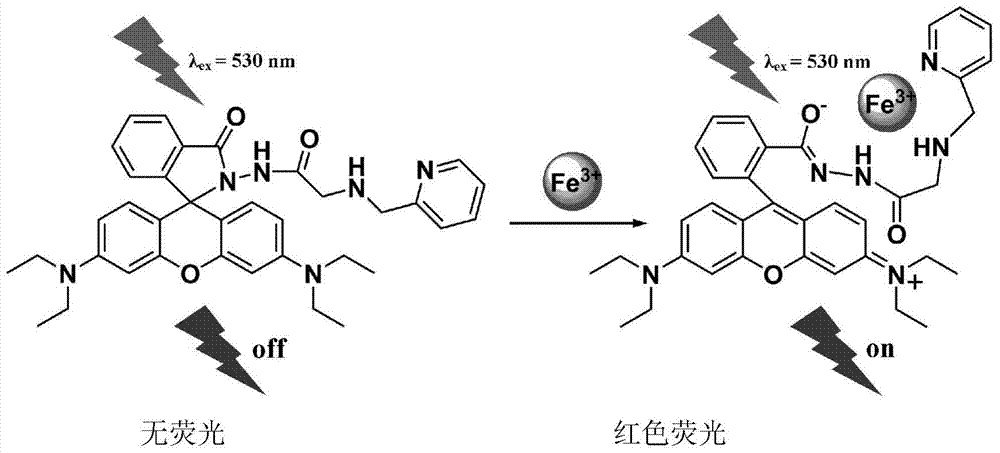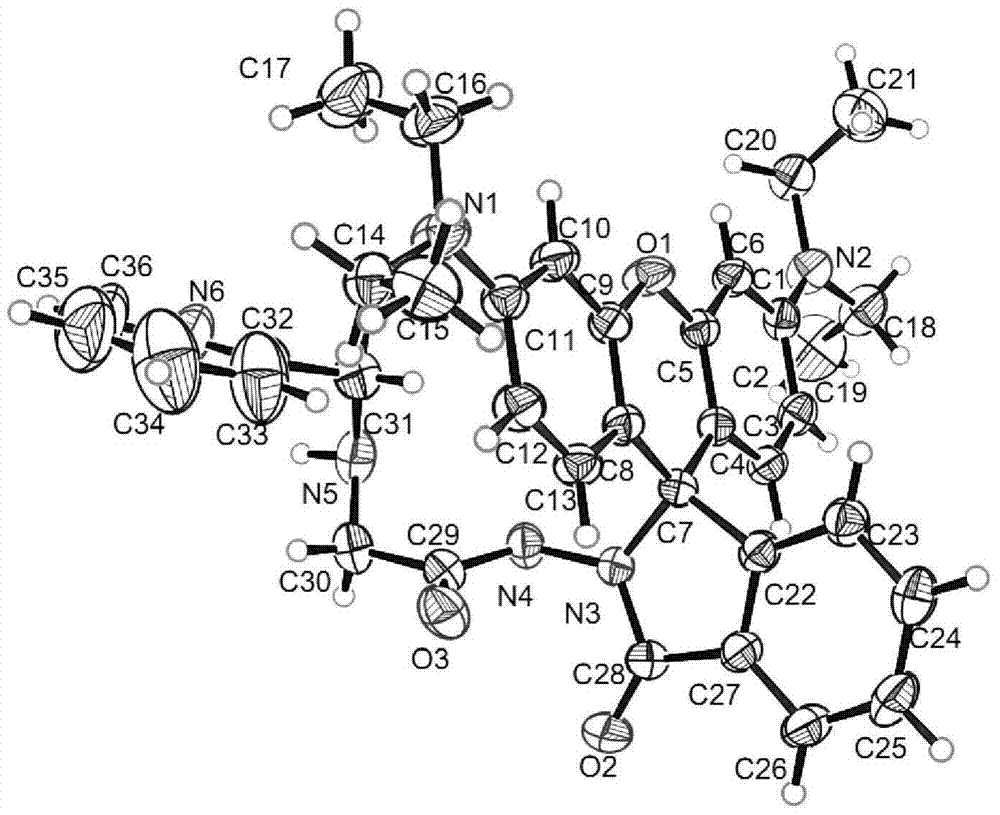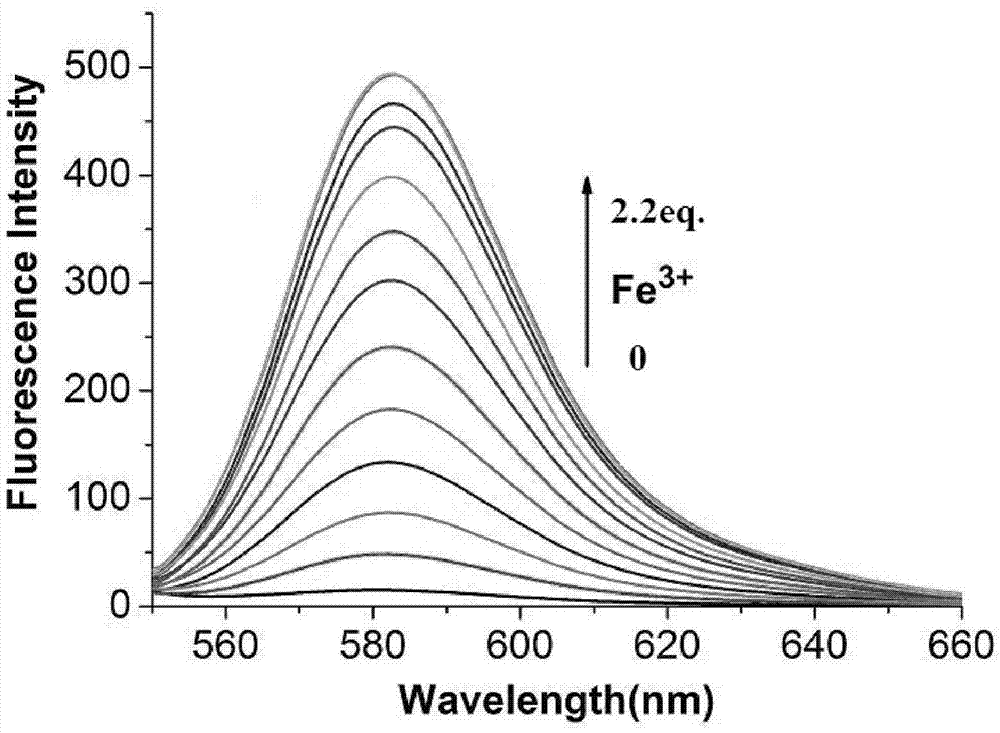A switch type ferric ion fluorescent probe and preparation method thereof
A technology of fluorescent probe and ferric iron, which is applied in the field of cation detection to achieve the effects of low detection concentration, simple operation and simple structure
- Summary
- Abstract
- Description
- Claims
- Application Information
AI Technical Summary
Problems solved by technology
Method used
Image
Examples
Embodiment 1
[0025] Embodiment 1: the synthesis of fluorescent probe molecule RD
[0026] 1. Synthesis of intermediate 1
[0027] Weigh 5g (11.22mmol) of rhodamine B and 0.67g (13.46mmol) of hydrazine hydrate into a round bottom flask, add 100mL of ethanol solvent, install a condenser, heat to reflux at 80°C, track with TLC until the reaction of the raw materials is complete, and stop the reaction . The solvent was spin-dried and recrystallized from ethanol to obtain 4.88 g (10.66 mmol) of intermediate 1 as a white solid with a yield of 95%.
[0028] 1 H NMR (CDCl 3 ,400MHz,ppm):δ:1.15(12H,t,J=7.02Hz),3.34(8H,q,J=7.00Hz),3.61(2H,s),6.45-6.29(6H,m),7.10( 1H,m),7.45(2H,m),7.93(1Hm). 13 C NMR (DMSO-d 6 ,100MHz,ppm),δ:12.41,43.64,64.71,97.35,105.4,107.73,122.12,123.47,127.68,132.36,148.06,151.85,152.99,165.26.
[0029] 2. Synthesis of Intermediate 2
[0030]Weigh 11.36g (3mmol) of the intermediate in a round-bottomed flask, add the solvent dichloromethane (10mL), and slowly add 0.76g o...
Embodiment 2
[0035] Embodiment 2: the selectivity of fluorescent probe molecule RD to ferric ion
[0036] Dissolve fluorescent probe molecules in methanol to prepare 1 mM mother solution, take 100 μL of the mother solution in a 10 mL volumetric flask, and then dilute to volume with HEPES aqueous solution (pH 7.0). When adding 40 times the equivalent (Na + ,Mg 2+ , Ca 2+ ) and 2 times the equivalent of various metal ions (Ag + ,Mn 2+ ,Cu 2+ ,Hg 2+ ,Pb 2+ , Fe 2+ ,Co 2+ , Ni 2+ ,Zn 2+ ,Cd 2+ ,Cr 3+ , Fe 3+ ), the fluorescent probe molecule is excited at 550nm to detect changes in the fluorescence spectrum. from Figure 4 It can be seen that the addition of various other metal ions will not cause the fluorescence change of the fluorescent probe. Only the ferric ion can affect the fluorescence change of the probe, and the chromium ion has a weak influence. Under the condition of co-existence, the fluorescent probe molecules are highly specific and selective to ferric ions.
Embodiment 3
[0037] Embodiment 3: the insensitivity of fluorescent probe molecule RD to pH
[0038] Using the response of the fluorescent probe molecule RD to pH, under the conditions of biological simulation, the pH of the fluorescent probe molecule is studied. At pH=6-9, the fluorescence intensity of the fluorescent probe molecule (RD) will not change with the pH while changing ( Figure 5 ), indicating that the fluorescent probe molecule of the present invention can be well applied in cell imaging.
PUM
 Login to View More
Login to View More Abstract
Description
Claims
Application Information
 Login to View More
Login to View More - R&D
- Intellectual Property
- Life Sciences
- Materials
- Tech Scout
- Unparalleled Data Quality
- Higher Quality Content
- 60% Fewer Hallucinations
Browse by: Latest US Patents, China's latest patents, Technical Efficacy Thesaurus, Application Domain, Technology Topic, Popular Technical Reports.
© 2025 PatSnap. All rights reserved.Legal|Privacy policy|Modern Slavery Act Transparency Statement|Sitemap|About US| Contact US: help@patsnap.com



